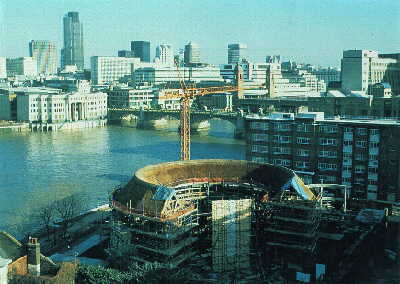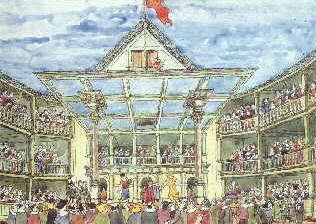 It is the recreation of Shakespeare's Globe Theatre, which is due to be completed late this summer. Public tours continue daily, despite the ongoing construction.
It is the recreation of Shakespeare's Globe Theatre, which is due to be completed late this summer. Public tours continue daily, despite the ongoing construction. LONDON -- It's been years in the making, it's not done yet, and it's one of the most popular tourist attractions in the city. Additionally, this most English of all projects was inspired by an American and is being financed internationally.
 It is the recreation of Shakespeare's Globe Theatre, which is due to be completed late this summer. Public tours continue daily, despite the ongoing construction.
It is the recreation of Shakespeare's Globe Theatre, which is due to be completed late this summer. Public tours continue daily, despite the ongoing construction.
One of the first public performances is scheduled to take place Aug. 21 when "The Two Gentlemen of Verona" will be produced by actors in a theatre as much like the original 1599 version as possible. There will be plenty of bugs to be worked out in this prologue season, with everything ready to go by the official opening planned for May of 1997.
But another public performance took place June 14, Founder's Day at the new Globe. This celebration paid tribute to the late Sam Wanamaker, the American actor and producer who originally conceived of the idea 48 years ago. He would no doubt be pleased to see how far his dream has come. For starting next year, plays will be offered in a regular season from May to September. During the winter months when the stage will be dark, visitors will still be able to tour the theatre.
During the season, performances will be at 2:30 and 6:30 p.m. There will be room for 500 people ("groundlings") to stand in front of the stage and seats for 1,000 others in the three-story building. In Shakespeare's day, plays took place at 2:30 in the afternoon when the stage was in the shade and the audience was in the sun. In those days, it cost one penny to stand in the yard and watch a play. It will cost five pounds or about $7.50 to stand there today.
But the theatre is going to be only one of six buildings including a museum, restaurant, 300-seat lecture hall and gift shop making up the non-profit International Shakespeare Globe Centre. The centre is due to be entirely completed in 1999, in time to mark the 400th anniversary of the original theatre.
 The original Globe, built nearby on the banks of the Thames, was destroyed by fire in 1613 when a spark from a stage canon used in a performance of "Henry VIII," set light to the thatched roof.
The original Globe, built nearby on the banks of the Thames, was destroyed by fire in 1613 when a spark from a stage canon used in a performance of "Henry VIII," set light to the thatched roof.
Measures are being taken to make sure fire doesn't destroy the new Globe's thatched roof, which was completed in 10 weeks by three people, two men and a woman (who was persistently and inevitably referred to as the lady thatcher). The roof was made up of 6,000 water reeds from Norfolk, coated with a fireproof chemical, and laid over a fireboard base. Green oaks were used for beams, just as in Shakespeare's day.
Shakespeare wrote 37 plays. Those, along with others of the era, will be performed at the new Globe. One day, you'll be able to arrive by boat along the Thames River as you would have in 1599. And how did people in Elizabethan London know that a play was being offered at the Globe?
Globe stage hands ran up a flag on top of the theatre to let the 200,000 Londoners know that a play was taking place that afternoon. The new Globe plans to have a flag, too. Everything, from the green oak beams to the goat hair in the plaster, is to be as authentic as possible.
The question is, will it be too authentic to sustain interest? Some fear so. "It will be a very popular draw for the first several years," said Patrick Parrinder, professor of English at Reading University. But after that, Parrinder thinks there's a good chance that interest will wan. The Globe's company won't be able to compete with the flash and special effects offered by other production companies.
Others think international interest will keep the new Globe going long into the next millenium. More than $45 million dollars has been raised so far and none of that has come from the British government.
|